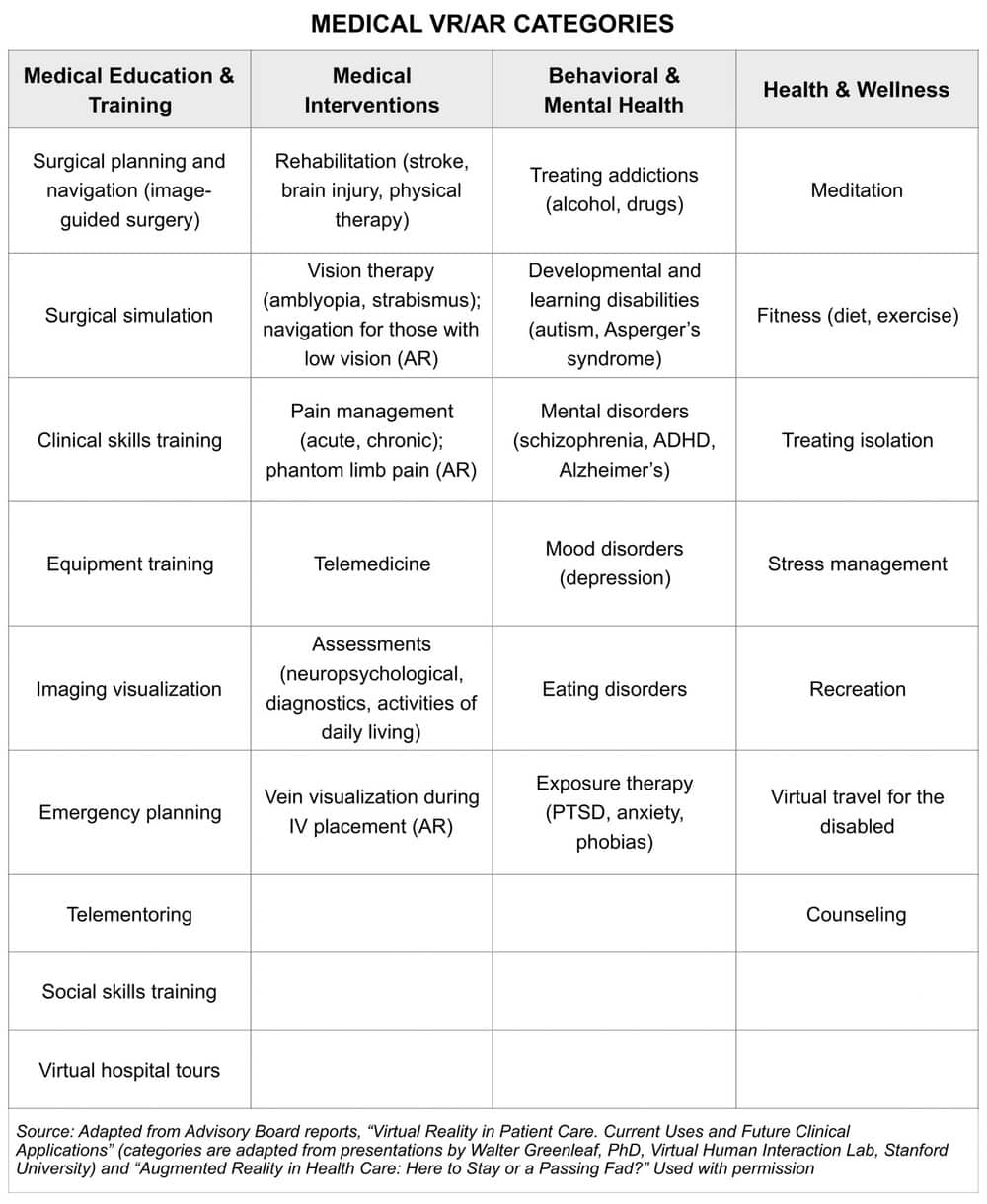ARTICLE SUMMARY:
Virtual reality and other tech-enabled digital tools are entering the healthcare education arena with a promise to make clinician training and assessment more flexible, efficient, and user-friendly. One of the most active pioneers in this space is medtech giant Johnson & Johnson. J&J’s professional education unit, the Johnson & Johnson Institute, is embracing a variety of digital learning tools, ranging from virtual and augmented reality to AI-driven online learning tools.
The video gaming industry may have brought virtual reality (VR) and its close cousin augmented reality (AR) into the mainstream, but others are taking this technology well beyond gaming and into new domains, one of which is healthcare (see Figure 1). Although more time and study are needed before VR/AR become commonplace in patient care, physicians could reap VR’s benefits as a training and planning tool much sooner.
In fact, some believe that VR, AR, and other high-tech tools could be game-changers when it comes to training and evaluating surgical staff in the hospital. As such, a digital learning environment that employs these types of tools in the clinical setting could have a wide-reaching impact on patient outcomes down the road, helping to level the surgical playing field on a global basis.
At least that’s the opinion of the folks at the Johnson & Johnson Institute, which was established last fall to bring together J&J’s diverse network of bricks-and-mortar and online professional education offerings. According to Sandra Humbles, VP of Global Education Solutions, Johnson & Johnson Medical Devices Companies (which consists of J&J’s surgery, orthopedics, and cardiovascular device businesses), the Johnson & Johnson Institute is leading the way in this effort, investing heavily in VR and other high-tech training solutions as part of its new “digital ecosystem.” The company’s aims, says Humbles, are to add more flexibility and efficiency to the clinician learning environment and expand access to high-level training in underserved areas worldwide.
To learn more about J&J’s plans for its digital learning environment and the potential impact VR and AR could have on physician training in the future, MedTech Strategist spoke recently with Humbles, who heads-up the Institute’s global education team, and her colleague David Badri, Virtual Reality Lead, WW Professional Education at Johnson & Johnson, who was instrumental in getting the VR training program up and running. What follows is an excerpt from that conversation. Read the full interview in the July 25, 2018 issue of MedTech Strategist.
MTS: What does virtual reality bring to the training process? And what prompted J&J to add this technology to its clinician training program?

A: The educational environment is changing, and one of the biggest shifts is in the way people want to learn. When you start thinking about your own children, or the residents coming out of school, they are not just using textbooks and the traditional hands-on training that many of our previous surgeons have gone through. They're looking for these innovative ways to first build cognitive skills, and then go into hands-on experiences to apply those skills. So there is a big changing dynamic with respect to how our younger surgeons want to learn.
The second problem that we’re also trying to solve is scalability and global scalability. One of the things that we really struggle with in some of the remote areas of the world is they don’t even have some of the fundamental training. So if you can start to use the huge innovation that is coming in the health tech space to get this training into the hands of people in some of the more remote areas, it really makes a difference on a global scale.
Those two dynamics led my team to think very differently about what clinician education will look like in the future. We did a lot of benchmarking and some really nice pilots and we’re starting to pick those technologies that really could be game changing. And one of those is virtual reality. In the past, a surgeon who wanted to learn the steps of a procedure may have watched some videos and then worked alongside an experienced surgeon. They would have started to learn how to do that procedure, and then at some point, they would have taken over leading a case. What we have been able to do now is change that whole experience by allowing that learner surgeon to come into the virtual world to be able to learn the procedural steps, and how the equipment comes into those procedural steps, and they can do it multiple times until they get really confident with the procedure. What we’re still working on is integrating that into our base offerings of education. But what we’re expecting to see is once they’ve been in the virtual reality world learning the procedure, when they then go into a hands-on lab or into the operating room, they are already showing a higher proficiency because they have actually already gone through that procedure multiple times with VR.

A: What we try to achieve is the ability to train in a flexible way. We know that it’s not only the technology itself; it’s also the environment that has changed. Younger surgeons don’t have the same time anymore to train due to work hour restrictions and all the factors in the hospital. And we need to address that. So they have a different approach in how they want to learn. They want to learn when they have time to learn. From that perspective, what we try to do with virtual reality is to give them the technical solution that allows them to train in a safe environment while providing them with the flexibility and the repeatability to really enhance their surgical techniques so that they can mentally prepare. We call this cognitive skills, but we also have some basic psychomotor skills that really, through this immersive environment, help them to memorize, to a certain degree feel, and integrate those movements into their body memory.

A: And, although we’ve been very laser-focused on the learner surgeon, the benefits actually go way beyond that because once you’ve created the experience, you can then let the resident surgeon learn, or you can let the nurse learn the procedure. This opens up access to learning a procedure across the entire care team, not just that primary owner of the procedure, the surgeon. And so this is why we’re really working on this now. This technology—the whole VR and AR capability—is really going to accelerate and get better and better. And we wanted to be in early. We wanted to be experimenting in key areas that could really make a difference to individual surgeon support, and also to that team approach I just mentioned.
MTS: Do you see a generational divide? Is it more challenging to get Virtual Reality into the hands of older surgeons who may want to learn a new technique or brush-up on their skills, but who may not be so comfortable with this kind of technology?

A: Last year we went out with the system to show it to senior orthopedic surgeons. And what we saw is a very high technology acceptance with virtual reality—there was no real correlation between age and the technology acceptance. It’s not like all the young guys love it and the old ones don’t. We saw a very high acceptance throughout all levels of experience. In fact, more than 90% of the surgeons, and these have been mainly senior surgeons, stated that they would recommend VR training to other surgeons. Which was a very high number for us.
What we’re trying to investigate now with new projects is the impact of virtual reality in terms of clinical results. We have started a scientific study on that side where we will investigate with an external institution the clinical impact of virtual reality training. We just kicked off with this, but at the end, we want to compare people who do virtual reality with people who do not do the virtual reality training and see how they perform afterward in a cadaver lab.
MTS: How does this effort benefit J&J more broadly? For example, will the addition of Virtual Reality and other digital tools help facilitate training on new surgical platforms, like the robotic systems J&J is developing? 
A: The education team is obviously giving insights to our research teams to help us to build into this. When you think of robotics and the digital surgery platforms J&J is working on, all the capability we’re building under the Institute is to enable that.
#CommunityBlog #MedTechStrategist #medicaldevice #medtech #marythompson #strategy #johnsonandjohnson #JNJ #VirtualReality #DigitalHealth #augmentedreality
![]() Trial MyStrategist.com and unlock 7-days of exclusive subscriber-only access to the medical device industry's most trusted strategic publications: MedTech Strategist & Market Pathways. For more information on our demographics and current readership click here.
Trial MyStrategist.com and unlock 7-days of exclusive subscriber-only access to the medical device industry's most trusted strategic publications: MedTech Strategist & Market Pathways. For more information on our demographics and current readership click here.

